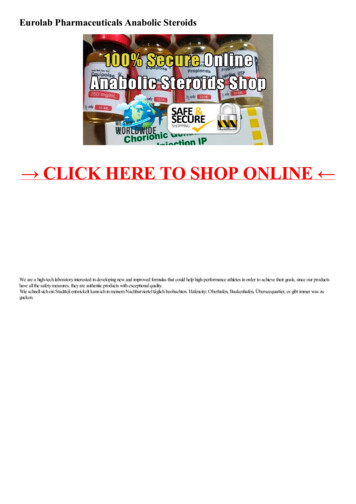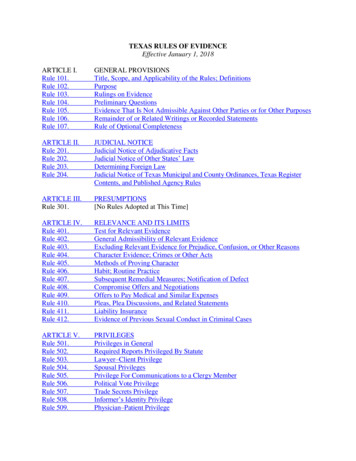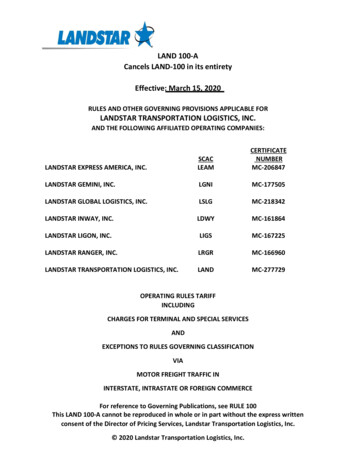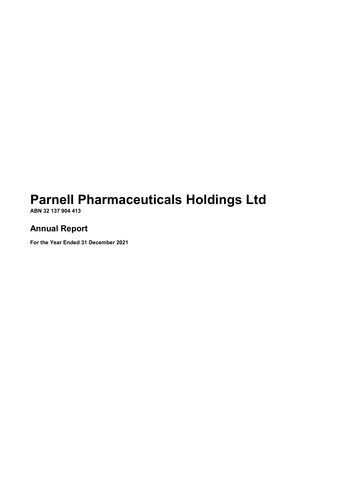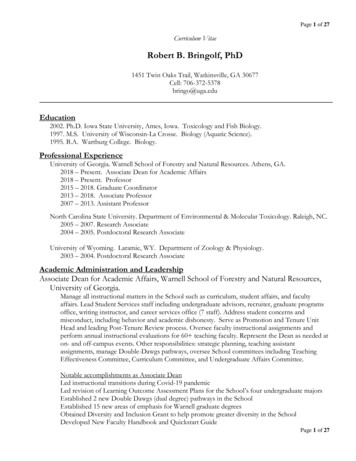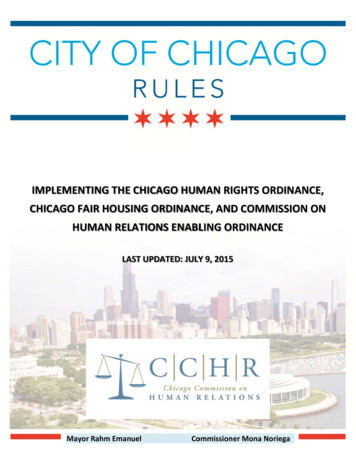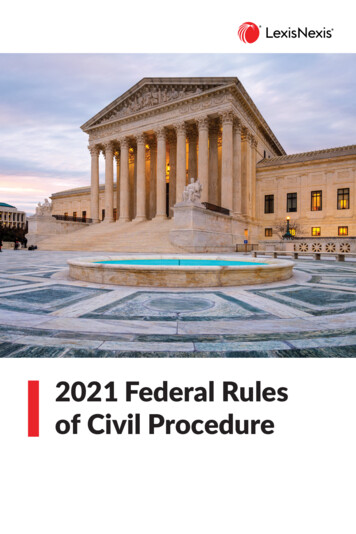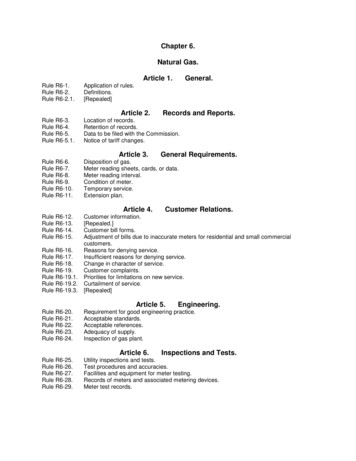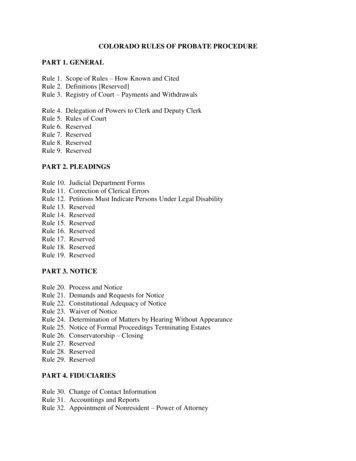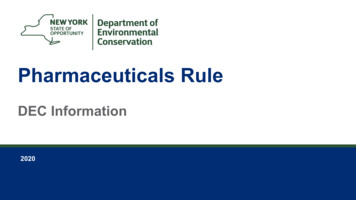
Transcription
1Pharmaceuticals RuleDEC Information2020
2Areas of Discussion1. Sewer Ban2. Amendment to the Listing of P075 for Nicotine3. Overall Pharmaceutical Rule EPA Subpart P
3Sewer BanGoes into effect on August 21, 2019 throughout US regardlessof state adoption. (HSWA authority)40 CFR 266.505 prohibits sewering of hazardous wastepharmaceuticals.Ban applies to all defined healthcare facilities and reversedistributors including CESQGs.
4Amendment of P075 DefinitionListing for nicotine and pyridine adds a parenthetical;“this listing does not include patches, gums and lozenges thatare FDA-approved over-the-counter nicotine replacementtherapies.”
5Pharms Rule: Nicotine ListingNicotine P075 ListingNo Longer Part of ListingFDA-approved over-the counternicotine replacement therapies(OTC NRTs) Nicotine Patches Nicotine Gums Nicotine LozengesStill Included in the Listing,Regulated as Pharmaceuticals*Still Included in Listing Prescription nicotine (e.g., nasalspray, inhaler) E-liquids packaged for retail usein ENDS Finished product ENDS,including components & partssealed in final packagingintended for consumer use E-liquids used by manufacturersof tobacco products E-liquids sold or distributed forfurther manufacturing, mixing orpackaging into a finished edelivery system Legacy pesticides containingnicotine Nicotine used in research andmanufacturing Other unused formulations(ENDS means Electronic NicotineDelivery System)*If generated by a health carefacility
6Reverse LogisticsPreamble to the Rule: EPA uses the preamble to the pharmacyrule to define their interpretation of Reverse Logistics.Reverse Logistics in not a part of Subpart P nor this rulemakingand will not be addressed in this discussion.
740 CFR 266Subpart PPharmaceuticalRule
8PART 266 Subpart P—Hazardous Waste Pharmaceuticals266.500 - Definitions for this subpart.266.501 - Applicability.266.502 - Standards for healthcare facilities managing non-creditable hazardous waste pharmaceuticals.266.503 - Standards for healthcare facilities managing potentially creditable hazardous waste pharmaceuticals.266.504 - Healthcare facilities that are very small quantity generators for both hazardous waste pharmaceuticalsand non-pharmaceutical hazardous waste.266.505 - Prohibition of sewering hazardous waste pharmaceuticals.266.506 - Conditional exemption for hazardous waste pharmaceuticals that are also controlled substances andhousehold hazardous waste pharmaceuticals collected in a take-back event or program.266.508 - Shipping non-creditable hazardous waste pharmaceuticals from a healthcare facility or evaluatedhazardous waste pharmaceuticals from a reverse distributor.266.509 - Shipping potentially creditable hazardous waste pharmaceuticals from a healthcare facility or a reversedistributor to a reverse distributor.266.510 - Standards for the management of potentially creditable hazardous waste pharmaceuticals andevaluated hazardous waste pharmaceuticals at reverse distributors.
9Part 266 Subpart P ApplicabilityPart 266 Subpart P is considered more stringent, and thereforeis NOT optional for: Statesto adopt Healthcare facilities and reverse distributorsHazardous waste pharmaceuticals must be managed underPart 266 Subpart P by: Allreverse distributors All healthcare facilities that generate above VSQG amounts ofhazardous waste
10Definition of PharmaceuticalPharmaceutical is a drug for use by humans orother animals and includes, but is not limited to: Dietary supplements Prescription drugs Over-the-counter drugs Homeopathic drugs Compounded drugs Investigational new drugs Pharmaceuticals remaining in non-emptycontainers PPE contaminated with pharmaceuticals Clean-up material from spills of pharmaceuticals Electronic nicotine delivery systems (ENDS)e.g. e-cigarettes, vaping pens Nicotine e-liquid/e-juice packaged for retailsale for use in ENDS. e.g. pre-filled cartridgesor vialsPharmaceutical does NOT include: Dental amalgamSharpsMedical waste
11Definition of Healthcare FacilityHealthcare Facility includes, but is not limited to: Ambulance services Wholesale distributors Pharmacies Third-party logistics providers (3PLs) that serve asforward distributors Long-term care pharmacies Military medical logistics facilities Mail-order pharmacies Hospitals Retailers of pharmaceuticals (includes vape shops) Psychiatric hospitals Veterinary clinics & hospitals Ambulatory surgical centers Health clinics Physicians’ offices Optical and dental providers Chiropractors Long-term care facilitiesHealthcare Facility does NOT include: Pharmaceutical manufacturers Reverse distributors Reveres logistics centers
12Definition of Long-Term Care FacilityLong-term Care Facility includes,but is not limited to: Hospice facilities Nursing facilities Skilled nursing facilities Nursing and skilled nursingcare portions of continuingcare retirement communitiesLong-term Care Facility doesNOT include: Group homes Independent livingcommunities Assisted living facilities Independent and assistedliving portions of continuingcare retirement communities
13Definition of Reverse DistributorReverse Distributor (RD) means Any person that receives and accumulates prescriptionpharmaceuticals that are potentially creditable hazardouswaste pharmaceuticals for the purpose of facilitating orverifying manufacturer credit Any person, including forward distributors, third-partylogistics providers, and pharmaceutical manufacturers, thatprocesses prescription pharmaceuticals for the facilitation orverification of manufacturer credit is considered a reversedistributor
14Types of HW PharmaceuticalsThere are 3 types of Hazardous Waste Pharmaceuticals: Non-creditable hazardous waste pharmaceutical (TSDF) Potentially creditable hazardous waste pharmaceutical(Reverse Distributor) Evaluated hazardous waste pharmaceutical (TSDF)
15
16Healthcare Facility Standards Notification: all healthcare facilities must submit a one-timenotification that they are operating under Subpart P (using Site IDForm: 8700-12) Facilities that are not required to submit a biennial report for their otherhazardous waste must notify within 60 days of the rule going into effect Non-authorized states: notifications will be due in October 20, 2019Facilities that are required to submit a biennial report may notify on theirnormal biennial reporting cycle Non-authorized states: notifications will be due with March 1, 2020 BR Training: all personnel managing non-creditable hazardous wastepharmaceuticals must be thoroughly familiar with proper wastehandling and emergency procedures relevant to their responsibilitiesduring normal facility operations and emergencies
Controlled Substances and Householdhazardous wastes Conditional exemptions for hazardous wastes that are alsocontrolled substances; and household wastepharmaceuticals collected at a take-back event or program Avoids dual regulation; Destroyed by a method approved by DEA in writing to meettheir non-retrievable standard; or in one of 5 types ofpermitted combustion units; These wastes don’t count towards generator category.17
18Conditional ExemptionIncludes: Hazardous waste pharmaceuticals that are also listed on aschedule of controlled substances by the Drug EnforcementAdministration (DEA) in 21 CFR part 1308, and Household waste pharmaceuticals collected in a take-backevent or program, including those that are collected by anauthorized collector registered with the DEA that comminglesthe household waste pharmaceuticals with controlledsubstances from an ultimate user.
19Pharmaceuticals Still Used in Healthcare that Are DEA ControlledSubstances & RCRA Hazardous WastesName of DrugOther Name(s)Medical UsesRCRA HWCodeDEA CSScheduleCommentChloral; Noctec, Somnote,SupprettesSedativeU034toxicIVUsed in hospitalpediatric units;common ingredientin vet anestheticsFentanylsublingual spraySubsysAnalgesicD001 ignitable IIIgnitable due toalcohol nticonvulsantD001 ignitable IVIgnitable due toalcohol contentTestosteronegelsAndrogel,Axiron,Fortesta, TestimHormoneD001 ignitable IIIIgnitable due to gelbaseValiuminjectableDiazepam, DiastatAnti-anxietyD001 ignitable IVIgnitable due toalcohol content
20DEA Controlled Substances & RCRA Hazardous Wastes Pharmaceuticalsthat Are Not in Common UseName of DrugOther Name(s)Medical UsesRCRA HWCodeDEA rimethyl-;ParalAnticonvulsantU182toxicIVNo longer incommon useParegoriccamphoratedAnalgesic,tincture of opium expectorant,antidiarrhealD001ignitableIIINo longer incommon useOpium TinctureLaudanamD001ignitableIINo longer incommon useAnalgesic,antidiarrheal
21Conditions of the Exemption Managed in compliance with the sewer prohibition of §266.505 and Collected, stored, transported, and disposed of in compliancewith all applicable DEA regulations; and Destroyed by a method that DEA has publicly deemed inwriting to meet their non-retrievable standard of destructionor combusted at one of the following:
22Conditional ExemptionCombustion options: A permitted large municipal waste combustor; A permitted small municipal waste combustor; A permitted hospital, medical and infectious wasteincinerator; A permitted commercial and industrial solid waste incinerator;or A permitted hazardous waste combustor.
23Options for VSQG Healthcare FacilitiesHealthcare Facilities that are VSQGs are not subject to Part 266 Subpart P,except the sewer prohibition but can: Opt into Subpart P and comply with all its provisions, OR Use the optional provisions of Part 266 Subpart P:1. A VSQG healthcare facility can continue to send potentially creditablehazardous waste pharmaceuticals to a reverse distributor2. A VSQG healthcare facility can send its hazardous wastepharmaceuticals off-site to another facility, provided the receiving facilityis either: A healthcare facility operating under Part 266 Subpart P and meetscertain conditions, OR An LQG operating under Part 262 and meets the conditions for offsite consolidation
24Options for VSQG Healthcare Facilities Cont.3. A long term care facility which is a VSQG can dispose of itshazardous waste pharmaceuticals in an on-site collection receptaclethat complies with DEA regulations Note: DEC collection receptacles can only be used for controlledsubstances that are from the ultimate user.4. A long-term care facility with 20 beds or fewer will be presumed to bea VSQG and not subject to Subpart P, except the sewer prohibition. Note: long-term care facilities with 20 beds may also be VSQGs
25Empty Containers New empty container standards apply to Containers with hazardous waste pharmaceuticals –acute & non-acute Healthcare facilities and reverse distributors subject to Part 266 Subpart P and Anyone else with containers of hazardous waste pharmaceuticals Residues remaining in “RCRA empty” containers are not regulated as hazardouswaste Can be used to determine whether a healthcare facility is subject to Part 266Subpart P Four different standards for different types of containers found in a healthcare setting Triple rinsing of containers with acute hazardous waste pharmaceuticals is notrequired/allowed anymore
26Stock, Dispensing & Unit-Dose ContainersA stock bottle, dispensing bottle, vial, or ampule (not to exceed1 liter or 10,000 pills); or a unit-dose container (e.g., a unit-dosepacket, cup, wrapper, blister pack, or delivery device) isconsidered empty and the residues are not regulated ashazardous waste provided the pharmaceuticals have beenremoved using the practices commonly employed to removematerials from that type of container.
27SyringesEmpty: if the contents have been removed by fully depressingthe plunger of the syringe.Not empty: the syringe must be placed with its remaininghazardous waste pharmaceuticals into a container that ismanaged and disposed of as a non-creditable hazardous wastepharmaceutical under this subpart and any applicable federal,state, and local requirements for sharps containers and medicalwaste.
28Intravenous (IV) Bags Considered empty and the residues are not regulated ashazardous waste if the pharmaceuticals in the IV bag havebeen fully administered to a patient. If an IV bag is not empty, the IV bag must be placed with itsremaining hazardous waste pharmaceuticals into a containerthat is managed and disposed of as a non-creditablehazardous waste pharmaceutical under this subpart, unlessthe IV bag held non-acute hazardous waste pharmaceuticalsand is empty as defined in § 261.7(b)(1).
29Other Containers, Including DeliveryDevicesHazardous waste pharmaceuticals remaining in all other typesof unused, partially administered, or fully administeredcontainers must be managed as non-creditable hazardouswaste pharmaceuticals under this subpart, unless the containerheld non-acute hazardous waste pharmaceuticals and is emptyas defined in § 261.7(b)(1) or (2). This includes, but is notlimited to, residues in inhalers, aerosol cans, nebulizers, tubesof ointments, gels, or creams.
30Shipments of HW PharmaceuticalsNon-Creditable & Evaluated Hazardous Waste Pharmaceuticals Both must be sent to a TSDFBoth must sent with manifest and Part 364 authorized hazardous waste transporterNon-creditable: healthcare facility must use “PHARMS” or “PHRM” code on manifest initem 13 (other hazardous waste codes are allowed but not required)Evaluated: reverse distributor must list all hazardous waste codes on manifestPotentially Creditable Hazardous Waste Pharmaceuticals Can be sent to a reverse distributor before going to a TSDF Manifest and hazardous waste transporter are NOT required Common carrier (e.g., UPS, USPS, FedEx) is acceptable Shipper must receive delivery confirmation from reverse distributor 35 days from date the shipment was sent Electronic delivery confirmation that common carriers use will typically be sufficient
31Reverse Distributor Standards A reverse distributor is a new type of hazardous waste management facility thatcan only accept hazardous waste that is “potentially creditable hazardous wastepharmaceuticals” No RCRA storage permit required No generator categories for reverse distributors (e.g., VSQG, SQG, LQG) All reverse distributors are regulated the same for hazardous wastepharmaceuticals Standards are similar to LQGs, with some additions: One-time notification as a reverse distributor Inventory of hazardous waste pharmaceuticals Security requirements
32Reverse Distributor Standards A reverse distributor must inventory and evaluate each potentiallycreditable hazardous waste pharmaceutical within 30 days orarrival to determine if it is destined for: Another reverse distributor (still considered “potentially creditable HWpharmaceutical”) orA permitted/interim status TSDF (considered “evaluated hazardous wastepharmaceutical”) Accumulation on-site at reverse distributor: 180 days maximum accumulation time after evaluation30 days evaluation180 daysaccumulation 210 daystotal per RD
33Reverse Distributor Standards Potentially Creditable hazardous waste pharmaceuticals No specific container or labeling standards Might not be included on Annual Report Evaluated hazardous waste pharmaceuticals Must designate an on-site accumulation area and conductweekly inspections Containers must be in good condition and managed to preventleaks Hazardous waste codes apply prior to offsite shipment Included on Annual Report
34Effective Dates Sewering ban – effective throughout US on effective date ofregulations (August 21, 2019). Other more stringent provisions –Enforceable by EPA on July 1, 2021 (it’s complicatedbecause EPA rule sets up the new mandatory Subpart P, butalternative requirements are not as strict as the ordinaryhazardous waste regulations)Less stringent provisions – effective when adopted by NYS byregulation, policy or enforcement discretion.
35Possible State Changes DEC is considering to require all healthcare facilities to notify within60 days of adoption of the rule and not allow the notification as part ofan annual report (DEC requirement vs biannual under EPA). DEC is considering to prohibit the incineration of HW pharmaceuticalscontaining mercury, even those with 1 percent total organic carbon.(IX. E. 3. of rule preamble)
36Possible State Changes Cont. Creditable HW pharms, do not become HW until they are evaluated,so the point of generation moves to the Reverse Distributor ormanufacturer. DEC plans to assess regulatory fees at that point ofgeneration. However, Non-Creditable HW pharmaceuticals are HW atthe HCF. EPA however proposes to not have them reported on theAnnual report. Because DEC must account for all HW in RegulatoryFees and Special Assessments, we would continue to require thatthey be included on the annual report. If a HCF chooses to alsohandle non-creditable non-HW pharmaceuticals under Subpart P,DEC needs to be able to distinguish these in the annual report fromnon-creditable HW pharmaceuticals.
37Possible State Changes Cont. EPA recommends that aerosols and liquids be put in sealed plasticbags, containers or other management practices during accumulationto reduce the risk of spills and releases. DEC is considering adoptingthis condition as a requirement. (XI. C. 1. d. of rule preamble) EPA doesn’t require labelling of potentially creditable hazardouswaste when being accumulated. EPA clearly says that states may bemore stringent. DEC is considering requiring a label with words like“Creditable Waste” or some other means to identify the materials,while not identifying them as pharmaceuticals. EPA chose to notrequire labels because of possible diversion of waste identified aspharmaceuticals. (XI. C. 1. d. of rule preamble)
38Possible State Changes Cont. DEC is considering to require LTC pharmacies to notify that they willbe receiving from LTCF VSQGs similar to the GeneratorImprovements Rule VSQG consolidation to LQG requirement. EPA’s shipping requirements for creditable HW Pharmaceuticalsunder Subpart P, does not include provisions for shipments which donot arrive in a timely manner or are undelivered that necessitatenotification to EPA. DEC is considering adding this requirement. The performance-based closure standard for Reverse Distributors donot contain all of the notification requirements for closure found in theGenerator Improvements Rule. DEC is considering adding thisrequirement. (XVII. C. 1. g. of rule preamble)
39Possible State Changes Cont. The rule does not require an accumulation date on the containers ofevaluated hazardous waste pharmaceuticals. The preamble statesthat states may require the accumulation start date. DEC intends toinclude this requirement. (XVII C. 3. d. of rule preamble) EPA did not define the term “business relation” in relation to the HCFconsolidation of a LTCF VSQG to a LTC pharmacy. DEC isconsidering not including this term as part of this requirement.
40Possible State Changes Cont.The rule will require at 266.508(a)(1)(iii)(C), that lab packs of HWpharms which contain metals D0(04,05,06,07,08,10 and 11) must bemarked with the appropriate waste codes. DEC is considering requiringa LDR form for these specific lab packs so the disposal facility knows ofthe implications of the metals. (XVI. A. 3. of rule preamble) approximately 6 pharmaceuticals have numerical LDRtreatment standards; one pharmaceutical containing metals (P012 – arsenictrioxide) can’t be adequately treated by incineration.
41How to CommentSubmit written comments: Email: HWregs@dec.ny.gov (Include "Comments onRegulatory Initiatives" in the subject line of the email) or Mail: Michelle Ching; Division of Materials Management;NYSDEC; 625 Broadway, Albany, NY 12233-7256
42Further Assistance Email: HWRegs@dec.ny.gov Phone: (518) 402-8651On DEC’s html
43Additional ResourcesThe regulation and other s-and-amendment-p075Complete archive of the March 4 CLU-IN webinar - ManagementStandards for Hazardous Waste Pharmaceuticals and Amendmentto the Hazardous Waste Listing for Nicotine: https://cluin.org/conf/tio/HazWastePharmaceuticals 030419/NYS DEC Hazardous Waste Pharmaceuticals Rulemakingwebpage: https://www.dec.ny.gov/regulations/117211.html
Includes: Hazardous waste pharmaceuticals that are also listed on a schedule of controlled substances by the Drug Enforcement Administration (DEA) in 21 CFR part 1308, and . state, and local requirements for sharps containers and medical waste. 28 Intravenous (IV) Bags Considered empty and the residues are not regulated as

